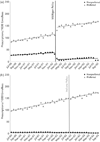Impact of prior authorization on the use and costs of lipid-lowering medications among Michigan and Indiana dual enrollees in Medicaid and Medicare: results of a longitudinal, population-based study
- PMID: 21397779
- PMCID: PMC3980661
- DOI: 10.1016/j.clinthera.2011.01.012
Impact of prior authorization on the use and costs of lipid-lowering medications among Michigan and Indiana dual enrollees in Medicaid and Medicare: results of a longitudinal, population-based study
Abstract
Background: Some Medicaid programs have adopted prior-authorization (PA) policies that require prescribers to request approval from Medicaid before prescribing drugs not included on a preferred drug list.
Objective: This study examined the association between PA policies for lipid-lowering agents in Michigan and Indiana and the use and cost of this drug class among dual enrollees in Medicare and Medicaid.
Methods: Michigan and Indiana claims data from the Centers for Medicare and Medicaid Services were assessed. Michigan Medicaid instituted a PA requirement for several lipid-lowering medications in March 2002; Indiana implemented a PA policy for drugs in this class in September 2002. Although the PA policies affected some statins, they predominantly targeted second-line treatments, including bile acid sequestrants, fibrates, and niacins. Individuals aged ≥18 years who were continuously dually enrolled in both Medicare and Medicaid from July 2000 through September 2003 were included in this longitudinal, population-based study, which included a 20-month observation period before the implementation of PA in Michigan and a 12-month follow-up period after the Indiana PA policy was initiated. Interrupted time series analysis was used to examine changes in prescription rates and pharmacy costs for lipid-lowering drugs before and after policy implementation.
Results: A total of 38,684 dual enrollees in Michigan and 29,463 in Indiana were included. Slightly more than half of the cohort were female (Michigan, 53.3% [20,614/38,684]; Indiana, 56.3% [16,595/29,463]); nearly half were aged 45 to 64 years (Michigan, 43.7% [16,921/38,684]; Indiana, 45.2% [13,321/29,463]). Most subjects were white (Michigan, 77.4% [29,957/38,684]; Indiana: 84.9% [25,022/29,463]). The PA policy was associated with an immediate 58% reduction in prescriptions for nonpreferred medications in Michigan and a corresponding increase in prescriptions for preferred agents. However, the PA policy had no apparent effect in Indiana, where there had been little use of nonpreferred medications before the policy was implemented (3.3%). The policies were associated with an immediate reduction of $24,548 in prescription expenditures in Michigan and an immediate reduction of $16,070 in Indiana.
Conclusions: The PA policy was associated with substantially lower use of nonpreferred lipid-lowering drugs in Michigan, offset by increases in the use of preferred medications, but there was less change in Indiana. Data limitations did not permit the evaluation of the impact of policy-induced switching on clinical outcomes such as cholesterol levels. The monetary benefit of PA policies for lipid-lowering agents should be weighed against administrative costs and the burden on patients and health care providers.
Copyright © 2011 Elsevier HS Journals, Inc. Published by EM Inc USA. All rights reserved.
Figures



References
-
- Lloyd-Jones D, Adams R, Carnethon M, et al. for American Heart Association Statistics Committee and Stroke Statistics Committee. Heart disease and stroke statistics—2009 update: A report from the American Heart Association Statistics Committee and Stroke Statistics Subcommittee [published correction appears: in Circulation. 2009;119:e182] Circulation. 2009;119:480–486. - PubMed
-
- National Cholesterol Education Program (NCEP) Expert Panel on Detection, Evaluation, and Treatment of High Blood Cholesterol in Adults (Adult Treatment Panel III) Third Report of the National Cholesterol Education Program (NCEP) Expert Panel on Detection, Evaluation, and Treatment of High Blood Cholesterol in Adults (Adult Treatment Panel III) final report. Circulation. 2002;106:3143–3421. - PubMed
-
- LaRosa JC, He J, Vupputuri S. Effect of statins on risk of coronary disease: A meta-analysis of randomized controlled trials. JAMA. 1999;282:2340–2346. - PubMed
-
- Vrecer M, Turk S, Drinovec J, Mrhar A. Use of statins in primary and secondary prevention of coronary heart disease and ischemic stroke. Meta-analysis of randomized trials. Int J Clin Pharmacol Ther. 2003;41:567–577. - PubMed
Publication types
MeSH terms
Substances
Grants and funding
LinkOut - more resources
Full Text Sources
Medical

